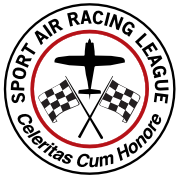- Home
- About SARL
- Media
- Race Hosts
- Race Results
- Race Memories
Sport Air Racing League
Racing for the Rest of Us!
You are here
The Course
Several factors should be taken into consideration when choosing and laying out your course.
Distance
The length of the typical SARL course runs from 100 to 500 miles.
Both extremes have their drawbacks depending on circumstances.
If the same point is to be used for both the start and finish line, then a short course is hazardous when a fast aircraft launching first might return to the start/finish line before the last aircraft is launched.
Typically aircraft are launched at 15-30 second intervals, so using the number of aircraft in the field you can see how long it will take to get all aircraft airborne (plus fudge factor).
Then using the speed that you expect the first aircraft to make, you can determine how long it will take to complete the course.
You should leave a 5 to 10 minute safety zone between last launch and first arrival.
A long course can be a deterrent to participation as some aircraft running at race RPMs (thus max fuel consumption) are unable to make the longer distances and have a good safety reserve.
Some race aircraft don’t carry enough fuel for a longer course even if they ran it at cruise speeds (Soneri, Cassutt).
For the types of aircraft common to the Sport Air Racing League, 100 to 400 miles are good course lengths to shoot for.
Airspace
The best race course, of course, is out in the sticks with no one and nothing around to be a hazard to the aircraft, or for which the aircraft may be considered a hazard.
Class “G” airspace is optimal. As you get closer to populated areas more care must be taken to choose a safe course line.
Waivers can be obtained for altitude and speed restrictions encountered inside the busier airspaces, up to and including Class “B” airspace, but the best thing is to keep the course out in the country.
Terrain
When you create a course you can make it as challenging as your terrain allows. The Central United States offers a lot of flat terrain, while the Western states can offer more interesting routes. Safety is paramount, however, and the reality is that engines do fail. Make sure that no part of the course is over “hostile” terrain and your racers always have a way out.
Turn Points
Almost every turn point you can think of to use for a race has positives and negatives.
Airports are easy to find, easy to program into the GPS, but when you get there you may have deal with non-race aircraft. This requires the turn be made above the traffic pattern altitude which means climbing which means slowing down (for most of us).
Natural landmarks are usually out in the sticks and might be a lake, hill top or other prominent point identifiable from the air. Since they are not man-made structures we can blow over them at race altitudes – as long as we can find them. Having a specific turn point at the landmark can be a problem, too, using something like a lake as a turn point.
Where, exactly, do we turn?
Towers, cross roads, towns, and other man-made structures have varying degrees of suitable as a turn point.
At a minimum there is the 500 foot separation demanded by the FARs. Worst case is the 1000 AGL minimum above a town.
Theme by Danetsoft and Danang Probo Sayekti inspired by Maksimer
